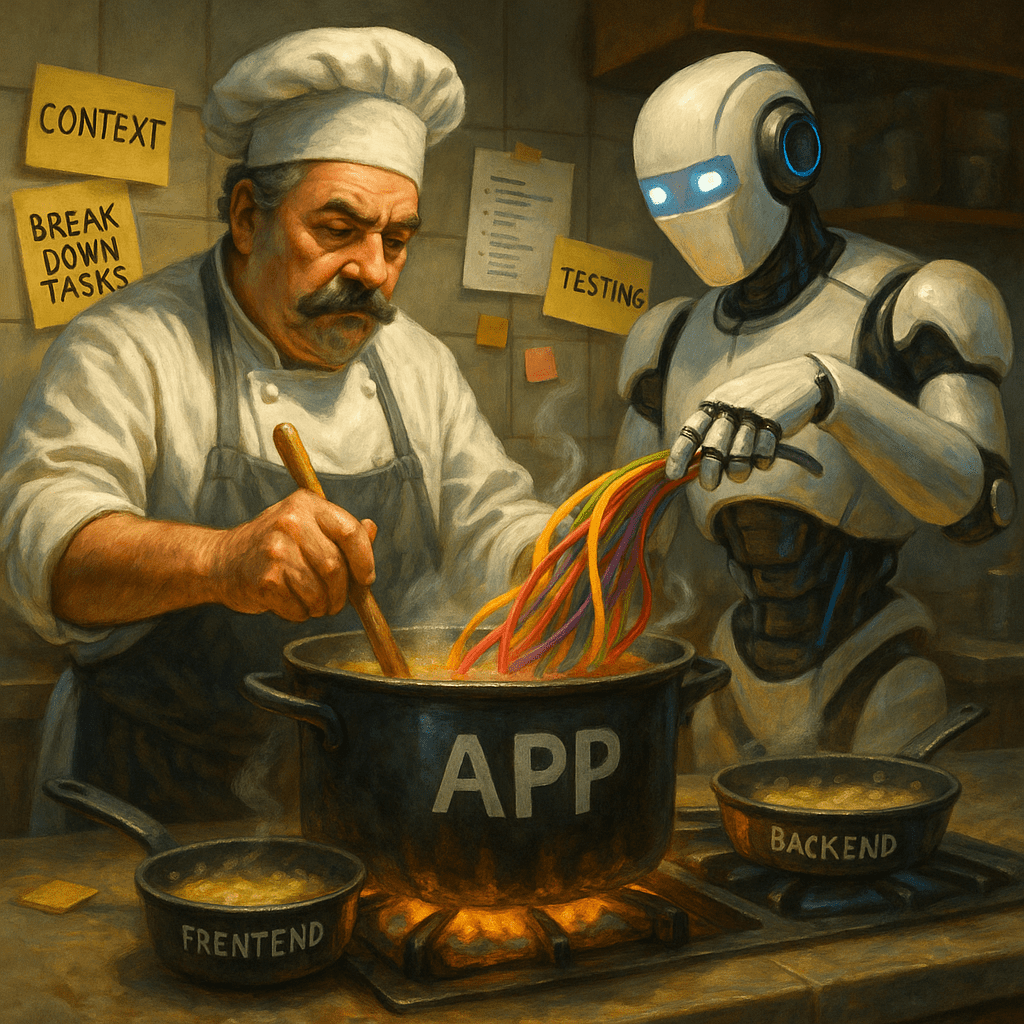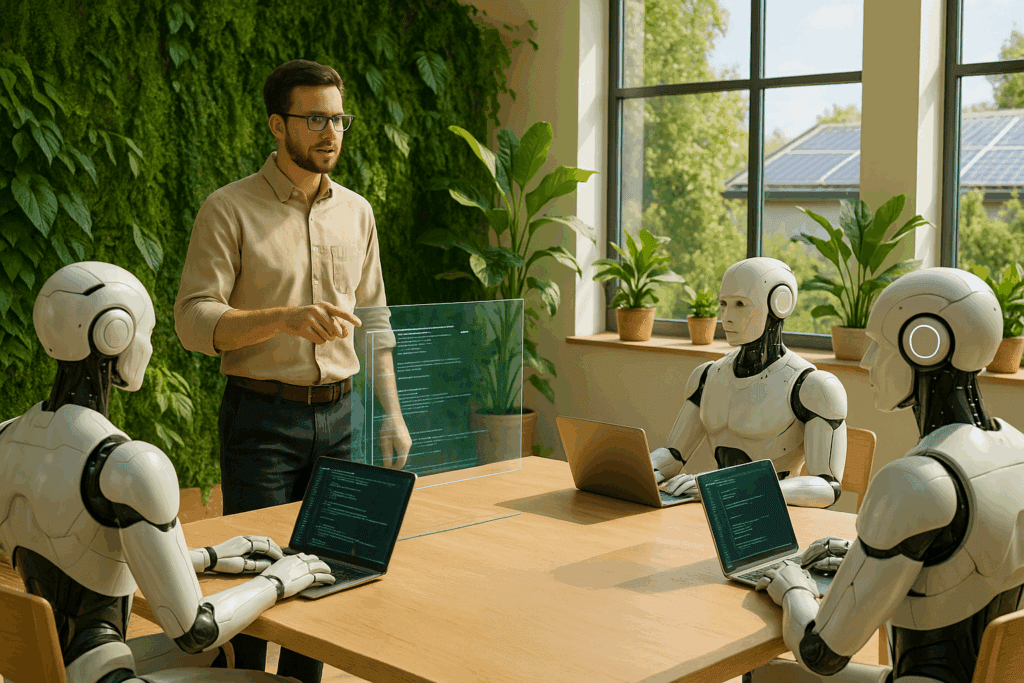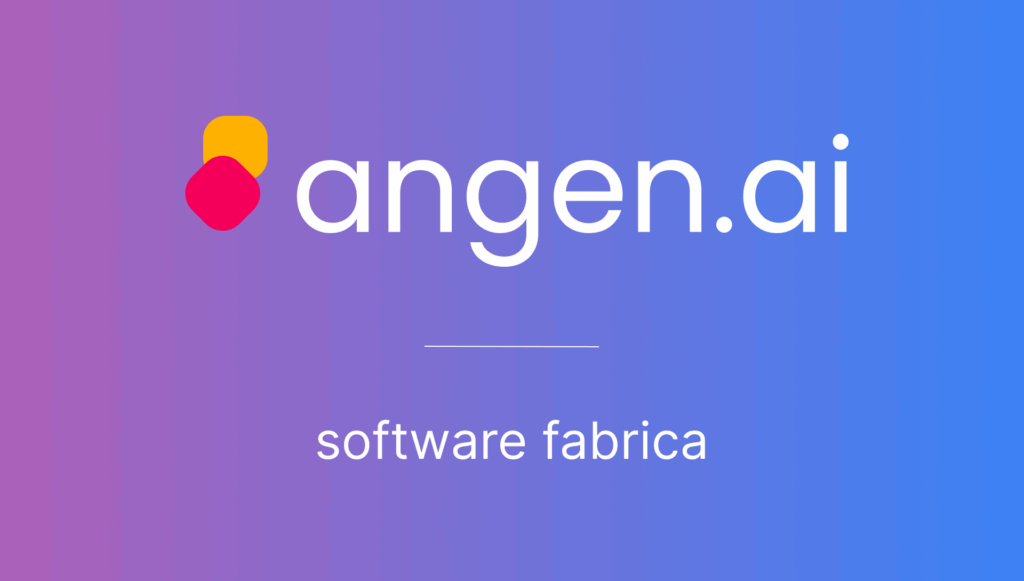When Organic and Artificial Intelligence Cook Together: A Communication Cookbook

When Organic and Artificial Intelligence Cook Together: A Communication Cookbook As AI systems become increasingly sophisticated and integrated into our development workflows, we’re discovering fundamental principles that govern effective human-AI collaboration. Whether you’re working with coding assistants, design tools, or any AI-powered system, these principles can dramatically improve your results and reduce frustration. Treat AI as Intelligence, Not Just a Tool The most important mindset shift is recognizing that you’re working with an artificial intelligence, not just a sophisticated autocomplete system. This means applying the same communication principles you’d use with any intelligent collaborator. When you ask a colleague to “build me a day planning app” and walk away, you shouldn’t be surprised if what they deliver doesn’t match your vision. The same applies to AI. The quality of your output is directly proportional to the clarity of your input. AI systems, like humans, have their own biases based on training data. Without clear direction, they’ll make assumptions that may not align with your intentions. The solution isn’t to blame the AI—it’s to communicate more effectively. Break Down Complex Tasks into Phases One of the biggest mistakes developers make is asking AI to solve everything at once. Instead, approach complex projects in manageable phases: 1. Start with Requirements Before jumping into code, ask your AI to help generate comprehensive requirements based on your initial specifications. AI can often augment your thinking by suggesting best practices and edge cases you might have missed. For example, instead of immediately requesting code, provide any relevant transcripts, discussions, or initial specifications and ask the AI to create detailed project requirements first. 2. Create an Implementation Plan Once requirements are clear, request a high-level implementation plan. This should outline what will be built for the UI, what APIs will be needed, and how different components will interact. You can review and refine this plan before any code is written. 3. Implement in Logical Order For full-stack features, consider implementing the backend API first, then the frontend. This ensures a clear contract between layers and reduces the degrees of freedom in subsequent steps. This phased approach prevents the frustrating scenario where the AI delivers working code that uses the wrong framework, follows different architectural patterns, or makes assumptions that don’t fit your maintenance requirements. Embrace the Low Cost of Generation Code generation costs almost nothing—just a few API calls and 5-10 minutes of time. This fundamentally changes how you should think about the development process. Many developers make the mistake of accepting mediocre generated code and then trying to fix it piece by piece. Instead, if the initial result doesn’t meet your standards, simply regenerate it. Don’t be attached to code that isn’t working for you. If you need 3-4 iterations to get a solid foundation, spending 20-30 minutes upfront can save you hours of manual coding. Remember, you would have taken breaks anyway during manual development—coffee breaks, YouTube videos, or just thinking time. The key insight: generated code has no inherent value. It’s only valuable if it serves your needs. Be willing to throw it away and start fresh. Apply Reasonable Standards When evaluating AI-generated code, apply the same standards you’d use for a colleague’s pull request. Ask yourself: if a team member submitted this exact code, would you approve it? Don’t reject code simply because it’s different from how you would have written it. Focus on whether it: Meets the business requirements Follows architectural guidelines Works correctly Is maintainable Minor differences in naming conventions or code organization aren’t grounds for rejection if the code is otherwise sound. You can always refactor later using your editor’s tools. Many developers fall into the trap of expecting AI to read their mind and produce code exactly as they envisioned it. This is unrealistic and counterproductive. The AI should match your requirements and technical specifications, not your unstated preferences. Provide Complete Context The completeness of your task specification directly impacts the quality of results. To get useful, integrated code, you must provide sufficient context: Include relevant project files: If you’re building a UI feature that needs to call APIs, include your existing service layer classes so the AI can integrate properly rather than recreating them. Document project conventions: Create a project guidelines document that gets included in requests, specifying preferred libraries, coding standards, and architectural approaches. Be explicit about constraints: If you have strong preferences about frameworks, databases, or third-party services, state them upfront. The more context you provide, the more consistent and appropriate your results will be. AI systems are surprisingly good at understanding and following project patterns when given sufficient information. The Iterative Refinement Process Effective AI collaboration is iterative, but it should converge toward your goals rather than wandering aimlessly. The step-by-step approach prevents the common problem where fixing one issue introduces new problems elsewhere. When you have clear requirements and implementation plans from earlier phases, subsequent refinements tend to stay on track. Each modification brings you closer to the target rather than introducing new deviations. Practical Implementation Here’s how these principles work in practice: Start with a conversation: Describe your project goals and constraints Generate requirements: Ask the AI to formalize specifications based on your input Review and refine: Iterate on requirements until they’re comprehensive Plan implementation: Request a technical approach and architecture overview Generate code in phases: Build foundational layers first, then build upon them Evaluate holistically: Judge results against formal criteria, not personal preferences Iterate or restart: If results are close, refine them; if they’re far off, regenerate Conclusion Working effectively with AI requires treating it as an intelligent collaborator while understanding its unique characteristics. By breaking down complex tasks, providing comprehensive context, and maintaining appropriate standards, you can achieve remarkably productive human-AI partnerships. The goal isn’t to make AI think exactly like you—it’s to harness its capabilities while guiding it toward outcomes that serve your real needs. When you master these principles, AI becomes a powerful force multiplier rather than a source of frustration. Remember: the future belongs to those
AngenAI User Guide: Automate Your Software Development

AngenAI Quick User Guide: Automate Your Software Development Table of Contents Welcome to AngenAI AngenAI revolutionizes software development by automating up to 80% of your coding process. This powerful AI assistant integrates seamlessly with your existing codebase, respects your company’s standards, and enables your team to focus on creativity and problem-solving rather than repetitive coding tasks. Whether you’re building a new feature, implementing a complex algorithm, or creating a UI component, AngenAI helps you complete these tasks faster and with greater consistency. Available for both Mac and Windows platforms, as well as through a web interface, AngenAI transforms software development into a more efficient, factory-like process. Getting Started with AngenAI Getting started with AngenAI is straightforward: Visit the AngenAI website: Go to angen.ai and click the “Download” button Create an account or log in: You can create an account using email/password or “Login with Google” Download the desktop app: Select the version for your operating system (macOS or Windows) Install and launch: Follow the installation instructions and open the application When you first launch AngenAI, you’ll go through an onboarding wizard that helps you: Create your first organization Set up your first project Configure your local source folder Formulate your first task for AngenAI After completing the wizard, you’ll be taken directly to the Work Item Workbench, where you can start working on your first task. Solving Your First Task with the Work Item Workbench The Work Item Workbench is the core interface where you interact with AngenAI. It consists of several key sections: Central Area At the center of the screen, you can write and edit your task description. Here you can also select which LLM you’ll be using (Claude or OpenAI) and choose a personality for the task. Context Panel (Left Side) This panel allows you to define the context for your task by selecting: Existing files from your project that provide relevant code patterns Articles from your knowledge base that contain guidelines or standards History Panel (Right Side) The history panel shows previous iterations of your task, allowing you to revert to earlier stages if needed. Creating and Processing a Task The workflow for using AngenAI is simple: 1. Write your task description in the central area, describing what you need as you would to a colleague 2. Click the arrow button to submit your task and start the generation process 3. Review the generated solution: The task description moves to the top Below is a file tree and code viewer showing the proposed changes For existing files, changes are displayed in a compare view similar to GitHub 4. Apply or refine the solution: If satisfied, select all or specific files and click “Apply Changes” If you need modifications, enter additional instructions in the prompt area below the code panel Click the arrow button again to continue the iteration Using the History Panel The History panel is valuable when you go through multiple iterations: If you feel the solution is going in the wrong direction, click on a previous generation in the History panel You can pick up files from earlier iterations or restart from that point with new prompts This makes it easy to explore different approaches without losing your progress Improving AI Performance with Knowledge Base and Personalities To enhance the quality of code generation, AngenAI provides two powerful customization features: Knowledge Base The Knowledge Base is where you store relevant information for reference during code generation: Organization-wide knowledge: Coding standards, security guidelines, and technical practices used throughout your company Project-specific knowledge: Requirements documents, technical specifications, and project-specific guidelines Adding comprehensive documentation to your Knowledge Base ensures that generated code adheres to your established practices and standards. Personalities Personalities in AngenAI allow you to tune how AI agents approach different types of tasks: 1. Personalities are equivalent to system prompts given to the LLMs 2. You can configure personalities for different types of specialists like: Development roles (React Developer, NextJS Developer, Flutter Developer) DevOps specialists Product managers System architects Personalities aren’t limited to code generation. You can use them to: Generate requirements based on client input documents stored in the Knowledge Base Create technical specifications based on requirements Design system architecture And then use all these outputs to generate code By combining a well-maintained Knowledge Base with appropriate Personalities, you can significantly improve the relevance and quality of AI-generated solutions across the entire software development lifecycle. Managing Projects and Organizations Projects Configuration Projects in AngenAI help you organize your work with specific settings: Create a new project by providing: A name A description (optional) The local source folder path The source folder path is crucial as it defines where AngenAI will look for your existing files when you select context in the Work Item Workbench. Organizations Management Organizations are the top-level structure in AngenAI: 1. You can create one or more organizations 2. Through Organization Management, you can control access to your organization by: Inviting users Assigning specific roles (owner, admin, member) 3. In Settings, you can view any invitations you’ve received to join other organizations Navigation and Quick Access AngenAI provides several navigation options for efficient workflow: 1. Switch between organizations and projects using the dropdown menu in the top-left corner 2. Access your account options including sign out from the icon in the top bar 3. Use the plus button in the top bar for quick creation of new work items without navigating to the Work Items section first Conclusion AngenAI transforms software development by automating repetitive coding tasks while maintaining your standards and coding practices. By effectively using the Work Item Workbench, Knowledge Base, and Personalities, you can significantly increase your development speed and maintain consistency across your projects. The platform is designed to be intuitive, following a natural
The Quiet Revolution: How AI is Redefining Software Development

The Quiet Revolution: How AI is Redefining Software Development Table of Contents Throughout history, progress has often been met with resistance. From the Luddites destroying mechanical looms to modern taxi drivers protesting ride-sharing apps, innovation disrupts established norms. Today, we’re witnessing a similar transformation in software development—a field that, ironically, has been instrumental in disrupting countless other industries while remaining somewhat resistant to its own evolution. Beyond the Art of Coding For decades, we’ve elevated programming to something akin to artistry. We’ve written books about clean code, debated the aesthetics of different languages, and developed cultural identities around our technology stacks. But we’ve lost sight of a fundamental truth: code itself is not the end goal. Code is simply a means to an end—a necessary bridge between human intent and computer execution. It exists because we haven’t yet developed hardware that can directly manifest our intentions. The value isn’t in the code itself but in what it enables. The Industrial Revolution of Software When I began my career, I worked on a project where one of the founders built a framework that automatically generated 80-90% of our backend code. This early experience showed me that software could be generated rather than painstakingly handcrafted. Since then, I’ve continually sought tools that minimize manual coding—Rapid Application Development frameworks, code generators, and now AI assistants. This progression follows a natural evolutionary path similar to other industries: Handcrafting (assembly language) Standardized components (high-level languages) Assembly lines (frameworks and libraries) Automation (AI-assisted development) Each stage has met resistance from those who mastered the previous paradigm, but each has ultimately prevailed because it delivers more value more efficiently. Engineering vs. Programming The emergence of AI in software development isn’t eliminating the need for human involvement—it’s elevating it. As routine coding tasks become automated, developers are freed to focus on higher-level engineering challenges. There’s a meaningful distinction between programming and engineering: Programming is implementing a solution when the path is clear Engineering is determining what to build when the problem is understood but the solution isn’t obvious AI tools excel at the former but struggle with the latter. They can generate code based on patterns they’ve observed, but they can’t yet make the creative leaps required to solve novel problems or understand the nuanced business context that shapes technical decisions. The Sustainable Balance Early resistance to AI code generation often focuses on quality concerns: “It doesn’t write code exactly as I would.” But this misses the point entirely. The goal isn’t to replicate human coding patterns—it’s to deliver functional software that meets business needs. Unlike RAD frameworks that often boxed developers into rigid patterns, AI assistants offer unprecedented flexibility. They can adapt to new requirements and generate custom solutions within minutes rather than days. This combination of adaptability and speed enables a more iterative, experimental approach to software development. The Future of Development As AI capabilities continue to advance, the role of software professionals will evolve toward: Problem definition and requirements clarification Architecture and system design Validation and quality assurance Business domain expertise Ethical oversight and decision-making The most successful teams will be those that embrace AI as a collaborator rather than viewing it as a threat. They’ll develop new workflows that leverage both human creativity and machine efficiency, creating a symbiotic relationship that delivers better software faster than either could alone. Embracing the Inevitable There’s a clear parallel between hand-assembled luxury cars and manually written code. While craftsmanship has its place, the market increasingly favors efficiency and accessibility. Just as few would pay a premium for a hand-assembled car that performs identically to its mass-produced counterpart, businesses won’t continue paying for manually written code when AI-generated alternatives deliver equivalent functionality at a fraction of the cost. This is simply practical evolution—and an opportunity. By embracing AI assistance, we can focus on the truly meaningful aspects of software development: solving complex problems, creating intuitive user experiences, and delivering business value. The industrial revolution in software development is already underway. The question isn’t whether AI will transform our field, but how quickly we’ll adapt to the new landscape it creates. Those who cling to the romantic notion of coding as an art form may soon find themselves in the position of artisanal craftsmen—respected for their skill but increasingly detached from the mainstream. Those who embrace the change will help shape a new era where software development becomes more accessible, efficient, and focused on outcomes rather than implementation details. The future belongs to the engineers, not the programmers.
AngenAI: Revolutionizing Software Development Through AI Automation

AngenAI: Revolutionizing Software Development Through AI Automation Table of Contents In today’s rapidly evolving tech landscape, the process of software development remains surprisingly manual. While technology has automated countless industries, the creation of software itself has largely resisted industrialization—until now. We’re excited to announce the launch of AngenAI, a revolutionary tool designed to transform how software is developed by leveraging the power of artificial intelligence. Automating the Software Development Process AngenAI is available as a desktop application, web interface, and as server-side agents that enable developers to generate complete solutions based on task descriptions, existing source files, or even create projects from scratch. Available for both Mac and Windows platforms, with server-side automation capabilities, AngenAI aims to automate the most tedious aspects of coding, allowing developers to focus on architecture, features, and delivering value rather than repetitive implementation tasks. “We do the most technically advanced things in the most outdated way. The process of creating software has always been very manual. Now we’re trying to automate it.” The truth is, our software production is like a factory lane with different workplaces—but the problem is that many steps in this factory lane are still done by hand, like in medieval ages. Sometimes our creativity is limited simply by how fast we can type! With AngenAI, we’re introducing AI machines that help people be more creative while handling common tasks automatically. How AngenAI Works The workflow in AngenAI centers around “work items”—tasks that are implemented with AI assistance. The system processes your requirements and generates code that respects your existing codebase and standards. Here’s what makes AngenAI special: Contextual Understanding The tool analyzes selected files from your project, ensuring that generated code integrates seamlessly with your existing codebase. This context-aware approach means you’re not getting generic solutions that need extensive modification—you’re getting tailored code that fits your specific environment. Organizational Structure AngenAI organizes work by projects and organizations, allowing teams to configure code generation according to their specific standards. This structure is particularly valuable for corporate environments where consistency across projects is essential. Knowledge Management The platform includes a knowledge base where you can store guidelines, tech stack documentation, and other project-specific information. This ensures that generated code always adheres to your established practices. Personalities AngenAI introduces the concept of “personalities” that influence how code is generated. These configurable settings allow you to specify formatting preferences, coding standards, and other stylistic elements that make the generated code feel like it was written by a member of your team. Version Control The tool maintains a history of all generations and modifications, allowing you to track changes, revert to previous versions, or edit messages and regenerate code if needed. This provides a safety net as you collaborate with the AI to refine solutions. Real-World Applications In a demonstration, AngenAI was used to create a chatbot for the Swedish police that could consult on labor-related court decisions. The entire solution, including document uploading, chat functionality, and vector database integration, was developed in approximately two hours. Another example showcased the implementation of a logging system for backend communications, completed in just two steps, demonstrating the tool’s versatility for both frontend and backend development tasks. The results are truly fantastic. Our AI coding machine alone can produce about 80% of the code needed for a user story implementation. This transforms software development into a fast and effortless process. Future Directions AngenAI represents just the beginning of a broader vision to automate the entire software development lifecycle. Future plans include: Project Planning: Enhancing task definition and requirements gathering through AI assistance Unattended Server-Side Operation: Allowing the system to listen for JIRA updates, check out projects, generate solutions, and create pull requests automatically Testing and Deployment: Extending automation to quality assurance and production deployment Imagine this: in a single day, we can take requirements from a client, transform them into tasks, then have AI pick up those tasks along with our knowledge base and coding standards to transform them into code. We demonstrate the solution, get feedback, make changes to the tasks, and regenerate the code. This entire iteration can happen within one day! There’s no need to spend countless hours fine-tuning every requirement—we can create, show, adjust, and show again. Getting Started AngenAI is currently available for free as we onboard early adopters. The team is actively seeking feedback to refine the tool and add new features based on real-world usage. Whether you’re struggling with UI development, need to quickly prototype a solution, or want to boost your productivity across the board, AngenAI offers a new approach to software development that could save countless hours of manual coding. Join us in bringing software development into the age of industrialization, where AI and human creativity combine to produce better software, faster. About the Team AngenAI is being developed by a dedicated team committed to revolutionizing software development processes. The team welcomes collaboration from interested developers who want to contribute to this transformative project. Just as AI-generated music can produce tracks so good people Shazam them (yet we still need live bands for that special creative spark and atmosphere), our goal with AngenAI is to blend together the best things that humans and AI can do for software development. We’re not replacing developers—we’re supercharging them. Ready to experience the future of software development? Connect with us to join our early access program and see how we can accelerate your software development.